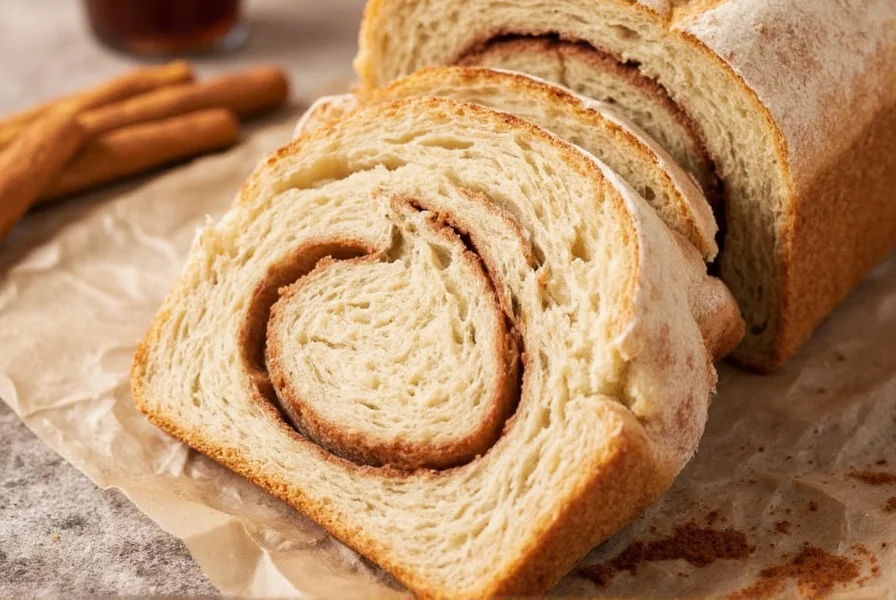The Unique Appeal of Sourdough Cinnamon Swirl Bread
Unlike standard cinnamon swirl bread made with commercial yeast, sourdough cinnamon swirl bread develops deeper flavor complexity through natural fermentation. The wild yeast and lactic acid bacteria in your starter create subtle tanginess that perfectly balances the sweetness of the cinnamon filling. This traditional method produces a more nuanced flavor profile while enhancing digestibility through extended fermentation.
Why Sourdough Changes Everything
The magic of sourdough cinnamon swirl bread lies in its fermentation process. While conventional recipes complete in hours, sourdough requires 12-24 hours of careful development. This extended timeline allows enzymes to break down complex carbohydrates and gluten, resulting in:
- Enhanced flavor complexity with subtle tanginess
- Improved texture with better crumb structure
- Increased shelf stability without preservatives
- Greater nutritional availability of grains
| Characteristic | Sourdough Cinnamon Swirl | Conventional Cinnamon Swirl |
|---|---|---|
| Fermentation Time | 12-24 hours | 2-3 hours |
| Leavening Agent | Natural starter | Commercial yeast |
| Flavor Profile | Complex, nuanced, subtle tang | Sweet, one-dimensional |
| Digestibility | Enhanced through fermentation | Standard |
Essential Ingredients for Authentic Flavor
Creating exceptional sourdough cinnamon swirl bread requires attention to ingredient quality. The starter should be active and bubbly, fed 4-12 hours before mixing. For the cinnamon filling, use Ceylon cinnamon rather than Cassia for its delicate flavor and lower coumarin content. The sugar mixture benefits from a combination of light brown sugar and a touch of molasses for depth.

Mastering the Swirl Technique
The signature swirl pattern separates good cinnamon bread from exceptional. After your dough completes bulk fermentation and has doubled in size, gently roll it into a 12x16 inch rectangle. Evenly distribute your cinnamon-sugar mixture, leaving a ½ inch border. The critical step: roll tightly from the long edge, pinching the seam closed. Rotate the loaf 90 degrees before placing in your pan to ensure proper rise direction.
Troubleshooting Common Issues
Even experienced bakers encounter challenges with sourdough cinnamon swirl bread. If your swirls disappear during baking, your dough was likely over-proofed. For filling that sinks to the bottom, you didn't create enough tension when rolling. A dense crumb typically indicates insufficient fermentation time or inactive starter. Remember that sourdough cinnamon swirl bread requires precise hydration levels—too wet and the filling leaks, too dry and the swirls won't develop properly.
Perfecting Your Baking Process
Temperature control proves crucial for optimal results. Bake at 375°F (190°C) for 35-40 minutes until internal temperature reaches 190°F (88°C). Create steam during the first 15 minutes by placing a pan of water in the oven bottom to enhance oven spring. Allow complete cooling before slicing—this patience ensures clean cuts through your beautiful swirl pattern. For best results, wait at least 2 hours before serving to allow flavors to fully develop.
Storage and Serving Recommendations
Sourdough's natural acidity extends shelf life compared to conventional bread. Store at room temperature in a linen-lined bread basket for 2-3 days. For longer storage, wrap tightly and freeze whole loaves. Never refrigerate sourdough bread as it accelerates staling. When serving, pair with cultured butter rather than margarine to complement the bread's natural tang. This artisan bread shines when enjoyed simply, though it transforms into exceptional French toast when slightly stale.
Frequently Asked Questions
Can I use discard starter for sourdough cinnamon swirl bread?
Yes, unfed discard works well for sourdough cinnamon swirl bread as the added sugar feeds the remaining microorganisms. However, for optimal rise, use discard that's no more than 12 hours old from feeding. Discard older than 24 hours may lack sufficient strength for proper fermentation, resulting in denser bread.
Why does my sourdough cinnamon swirl bread collapse after baking?
Collapsing typically indicates over-proofing before baking. Sourdough cinnamon swirl bread requires careful monitoring during final proof—when properly proofed, the dough should spring back slowly when gently pressed. Over-proofed dough lacks structural integrity. Additionally, ensure your oven temperature is accurate; underheated ovens prevent proper oven spring.
How can I prevent the cinnamon filling from leaking during baking?
To prevent leakage, use a thick cinnamon-sugar paste rather than dry mixture. Combine your filling ingredients with 1-2 tablespoons of melted butter to create a spreadable paste that adheres to the dough. Also, ensure proper tension when rolling the dough and leave a clean edge without filling along the seam to seal effectively. Chilling the shaped loaf for 20 minutes before baking helps set the filling.
What's the ideal hydration level for sourdough cinnamon swirl bread?
The optimal hydration range is 65-70% for sourdough cinnamon swirl bread. Higher hydration creates more open crumb but risks filling leakage. Lower hydration yields tighter crumb that holds swirl patterns better but may become dense. Adjust based on your flour type—bread flour typically requires 5-10% more water than all-purpose flour to achieve the same hydration level.
Can I make sourdough cinnamon swirl bread without a stand mixer?
Absolutely. Hand mixing and kneading works perfectly for sourdough cinnamon swirl bread. Use the coil fold technique during bulk fermentation instead of traditional kneading. Perform 4-6 sets of stretches and folds at 30-minute intervals during the first 2 hours of bulk fermentation. This develops gluten structure gently while preserving the delicate air bubbles essential for proper texture.










 浙公网安备
33010002000092号
浙公网安备
33010002000092号 浙B2-20120091-4
浙B2-20120091-4